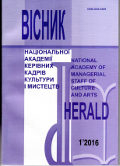LEMKO FOLK CLOTHING AS A SEMIOTIC SYSTEM
DOI:
https://doi.org/10.32461/2226-3209.1.2016.138476Keywords:
semiotics, analysis, symbol, communication, Lemko folk costume,Abstract
This article aims to outline peculiarities of Lemko folk-costume as a semiotic system. Folk clothes can be perceived as a part of a particular culture, but also it could be viewed as: a mean of communication between people and nations, mean of identity and differentiation, which could serve to differentiate one nation from another. In this article we will try to treat lemko folk costume as a semiotic system. Semiotics – investigates communicational systems and signs by means of which people communicate [2, 15].
This science emerged as a method applied in linguistics and later semiotic analysis was also applied to nonverbal costume can also be treated as a system of signs in which each element becomes a meaningful message, understandable by those who understand the "language" of that system.
The folk costume can be treated as a symbolic system in which each element has its own meaning comprehensible by those, who understand such "language". In this sense, folk clothes act as a kind of social code, which accumulates social and cultural experience of the particular group, as well as their values, beliefs, historical and geographical influences[4, 68].
As multifunctional phenomena folk costume not only translates ethnocultural experience in historical perspective by preserving the relations between various generations within one sub-group or ethnos, but also it absorbs intercultural interactions and influences from other ethnocultural systems.
Bearing in mind the history of lemko ethnograpical group, in particular: its location at the borderline of Ukrainian, Polish and Slovak cultures and its rather detached from the rest of Ukrainian nation position in terms of political and territorial connectedness, we can see that lemko folk costume reflects the diversity and complexity of such position. Within the lemko folk costume we can outline the following few groups of elements:
- Unique and distinctive elements, which emerged due to: geographical location, domestic environment, aesthetic preferences and beliefs of lemko group
- Elements which exploit trans-Ukrainian, nation-wide sociocultural codes
- Elements which emerged as a result of intercultural communication with Polisha and Slovak cultures and
which were integrated partly of completely into the semiotic field of the lemko folk costume
As we see, applying the semiotic method to this study of the Lemko folk costume yields certain benefits, namely: it allows analyzing folk costume in its diversity, allows dismantling the costume into separate components, and allows to group those components into three general groups. All these would help to shed some light into the genealogy and history of the aesthetic development of the Lemko folk costume, as well as this could help us understand the identity of the Lemko group as an ethnos.
Lets apply this approach to such a distinctive item of the lemko folk costume, as "chuganya" or "chuga" (which is a kind of a wool coat). Chuganya served as a symbol of prosperity and well-off status and also was an important element of the wedding clothes. Such item of clothes was unique lemko type not found elsewhere, not among Polish and Slovak folk clothes, nor among mainland Ukrainian folkware. Within lemko group the general design (cut) of this type of clothes was alike the only distinction was shape and decoration of the collar, however these features (shape and decoration of the collar) served as crucial indicators of the origin of particular chuganya’s owner and of its social status.
Lemko folk costume appeared to be a model of not only Lemko, but also a much wider – Ukrainian culture, as it was a bright depiction of intercultural communication of Lemkos with other cultures, hence it served as poly-functional phenomena, which on one hand differentiates ethnos one from another, and, on the other hand, it marks their interaction.
As such, Lemko folk costume has a number of elements borrowed from other nations’ costumes. For example, certain manners of sleeve decoration of women’s shirts adopted from Polish tradition, or certain decoration of men’s trousers adopted from Slovak tradition. Such adopted elements endorse the fact that Lemko folk costume developer over the time and that it contains several semiotic units borrowed from other nations while still remaining unique on its own.
From this perspective traditional folk costume serves as a collective phenomena formed by common culture and as an important indication of ethnical affiliation. Semiotic peculiarities of the folk clothes are expressed in their color, decoration, rithual usage etc, they all provide important information not only about particular persons (owners of the clothes), but also about the community as a whole within particular time horizon.
Downloads
Published
Issue
Section
License
Authors who publish with this journal agree to the following terms:
1. Authors retain copyright and grant the journal right of first publication with the work simultaneously licensed under a Creative Commons Attribution License International CC-BY that allows others to share the work with an acknowledgement of the work's authorship and initial publication in this journal.
2. Authors are able to enter into separate, additional contractual arrangements for the non-exclusive distribution of the journal's published version of the work (e.g., post it to an institutional repository or publish it in a book), with an acknowledgement of its initial publication in this journal.
3. Authors are permitted and encouraged to post their work online (e.g., in institutional repositories or on their website) prior to and during the submission process, as it can lead to productive exchanges, as well as earlier and greater citation of published work (See The Effect of Open Access).


